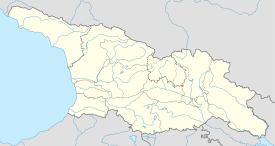Gremi
| Gremi გრემი |
|
|---|---|

Gremi
|
|
| Basic information | |
| Location | Kakheti Province (Mkhare), |
| Geographic coordinates | 42°00′07″N 45°39′36″E / 42.002047°N 45.660031°ECoordinates: 42°00′07″N 45°39′36″E / 42.002047°N 45.660031°E |
| Affiliation | Georgian Orthodox Church |
| Region | Caucasus |
| Architectural description | |
| Founder | Levan of Kakheti |
| Completed | 1565–1577 |
Gremi (Georgian: გრემი) is a 16th-century architectural monument – the royal citadel and the Church of the Archangels – in Kakheti, Georgia. The complex is what has survived from the once flourishing town of Gremi and is located southwest of the present-day village of the same name in the Kvareli district, 175 kilometers east of Tbilisi, capital of Georgia.
Gremi was the capital of the Kingdom of Kakheti in the 16th and 17th centuries. Founded by Levan of Kakheti, it functioned as a lively trading town on the Silk Road and royal residence until being razed to the ground by the armies of Shah Abbas I of Persia in 1615. The town never regained its past prosperity and the kings of Kakheti transferred their capital to Telavi in the mid-17th century. There was big Armenian population. The Russian diplomat Fedor Volkonsky, who was here in the 17th century, said: "Armenians have own church and market behind one was other church". He also said about 10 Armenian churches near the palace of king
The town appears to have occupied the area of approximately 40 hectares and to have been composed of three principal parts – the Archangels’ Church complex, the royal residence and the commercial neighborhood. Systematic archaeological studies of the area guided by A. Mamulashvili and P. Zak’araia were carried out in 1939-1949 and 1963-1967, respectively. Since 2007, the monuments of Gremi have been proposed for inclusion into the UNESCO World Heritage Sites.
The Archangels’ Church complex is located on a hill and composed of the Church of the Archangels Michael and Gabriel itself, a three-story castle, a bell tower and a wine cellar (marani). It is encircled by a wall secured by embrasures, turrets and towers. Remains of the secret tunnel leading to the Ints’obi River have also survived.
...
Wikipedia

